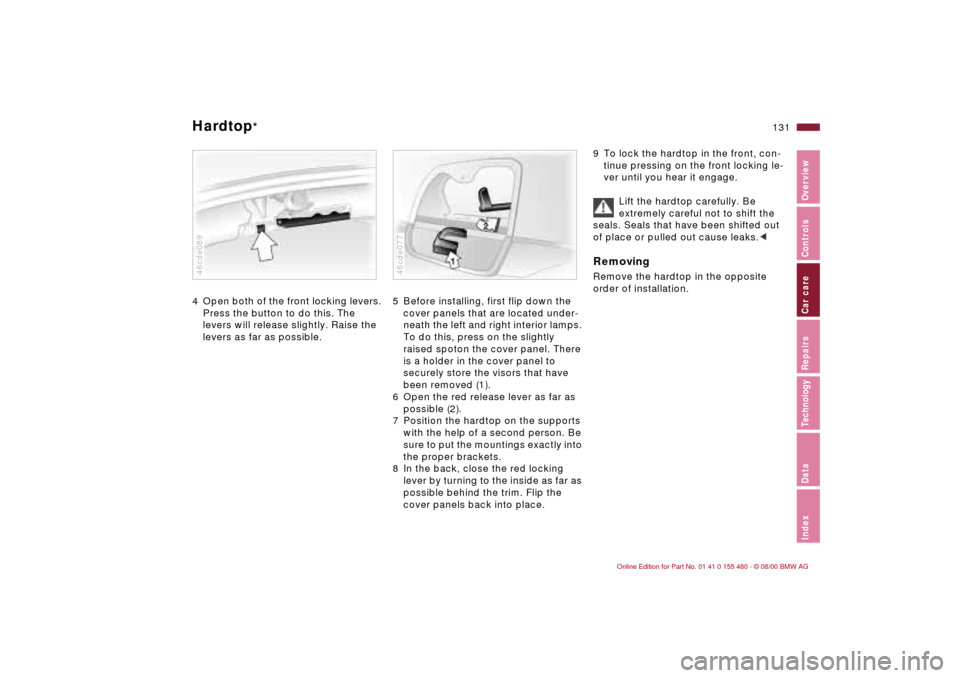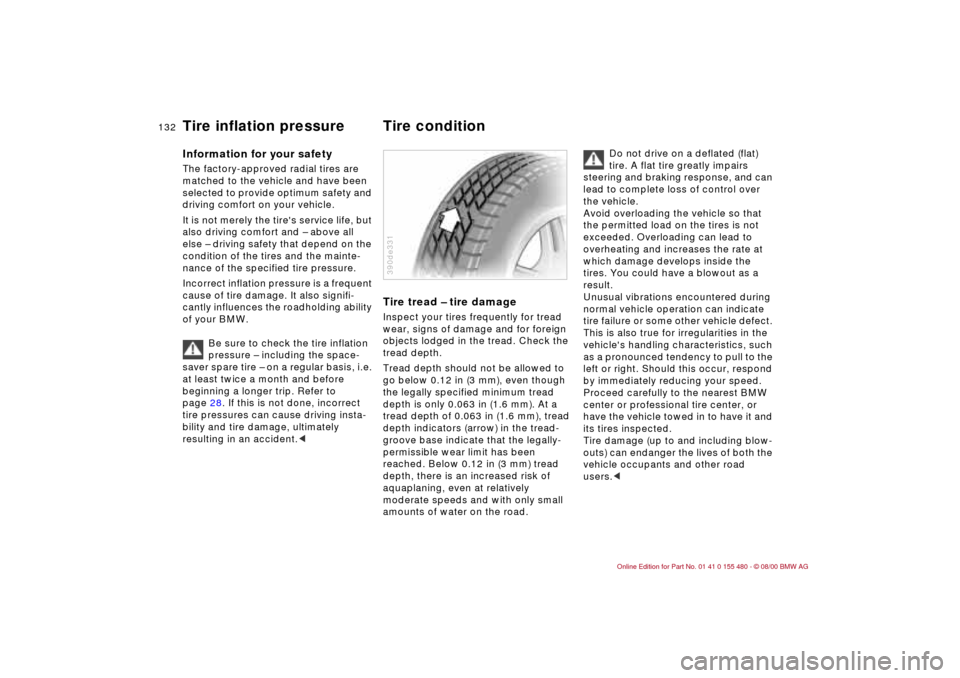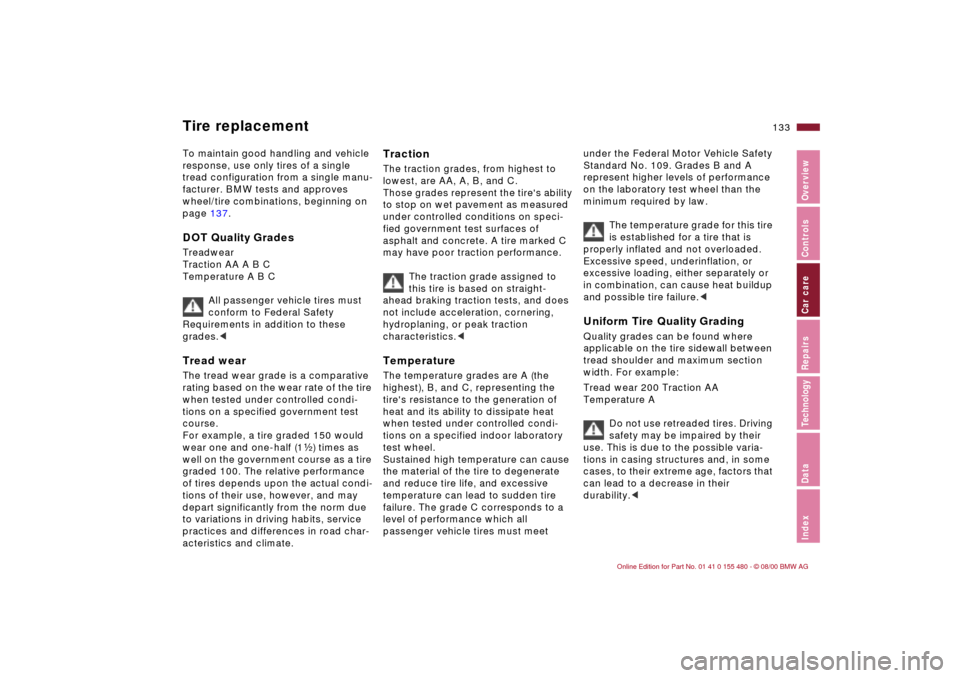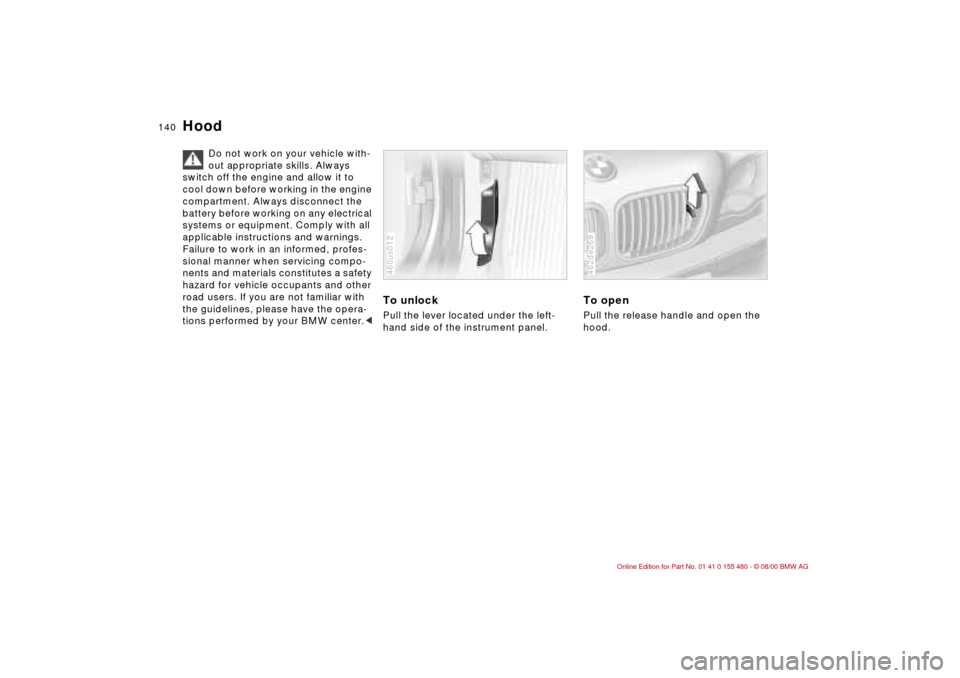BMW 330Ci CONVERTIBLE 2001 E46 Owner's Manual
Manufacturer: BMW, Model Year: 2001, Model line: 330Ci CONVERTIBLE, Model: BMW 330Ci CONVERTIBLE 2001 E46Pages: 215, PDF Size: 2.1 MB
Page 131 of 215

131n
IndexDataTechnologyRepairsCar careControlsOverview
Hardtop
*
4 Open both of the front locking levers.
Press the button to do this. The
levers will release slightly. Raise the
levers as far as possible.46cde089
5 Before installing, first flip down the
cover panels that are located under-
neath the left and right interior lamps.
To do this, press on the slightly
raised spoton the cover panel. There
is a holder in the cover panel to
securely store the visors that have
been removed (1).
6 Open the red release lever as far as
possible (2).
7 Position the hardtop on the supports
with the help of a second person. Be
sure to put the mountings exactly into
the proper brackets.
8 In the back, close the red locking
lever by turning to the inside as far as
possible behind the trim. Flip the
cover panels back into place.46cde077
9 To lock the hardtop in the front, con-
tinue pressing on the front locking le-
ver until you hear it engage.
Lift the hardtop carefully. Be
extremely careful not to shift the
seals. Seals that have been shifted out
of place or pulled out cause leaks.cRemovingRemove the hardtop in the opposite
order of installation.
Page 132 of 215

132n
Information for your safetyThe factory-approved radial tires are
matched to the vehicle and have been
selected to provide optimum safety and
driving comfort on your vehicle.
It is not merely the tire's service life, but
also driving comfort and Ð above all
else Ð driving safety that depend on the
condition of the tires and the mainte-
nance of the specified tire pressure.
Incorrect inflation pressure is a frequent
cause of tire damage. It also signifi-
cantly influences the roadholding ability
of your BMW.
Be sure to check the tire inflation
pressure Ð including the space-
saver spare tire Ð on a regular basis, i.e.
at least twice a month and before
beginning a longer trip. Refer to
page 28. If this is not done, incorrect
tire pressures can cause driving insta-
bility and tire damage, ultimately
resulting in an accident.<
Tire tread Ð tire damageInspect your tires frequently for tread
wear, signs of damage and for foreign
objects lodged in the tread. Check the
tread depth.
Tread depth should not be allowed to
go below 0.12 in (3 mm), even though
the legally specified minimum tread
depth is only 0.063 in (1.6 mm). At a
tread depth of 0.063 in (1.6 mm), tread
depth indicators (arrow) in the tread-
groove base indicate that the legally-
permissible wear limit has been
reached. Below 0.12 in (3 mm) tread
depth, there is an increased risk of
aquaplaning, even at relatively
moderate speeds and with only small
amounts of water on the road.390de331
Do not drive on a deflated (flat)
tire. A flat tire greatly impairs
steering and braking response, and can
lead to complete loss of control over
the vehicle.
Avoid overloading the vehicle so that
the permitted load on the tires is not
exceeded. Overloading can lead to
overheating and increases the rate at
which damage develops inside the
tires. You could have a blowout as a
result.
Unusual vibrations encountered during
normal vehicle operation can indicate
tire failure or some other vehicle defect.
This is also true for irregularities in the
vehicle's handling characteristics, such
as a pronounced tendency to pull to the
left or right. Should this occur, respond
by immediately reducing your speed.
Proceed carefully to the nearest BMW
center or professional tire center, or
have the vehicle towed in to have it and
its tires inspected.
Tire damage (up to and including blow-
outs) can endanger the lives of both the
vehicle occupants and other road
users.<
Tire inflation pressure Tire condition
Page 133 of 215

133n
IndexDataTechnologyRepairsCar careControlsOverview
To maintain good handling and vehicle
response, use only tires of a single
tread configuration from a single manu-
facturer. BMW tests and approves
wheel/tire combinations, beginning on
page 137.DOT Quality Grades Treadwear
Traction AA A B C
Temperature A B C
All passenger vehicle tires must
conform to Federal Safety
Requirements in addition to these
grades.< Tread wearThe tread wear grade is a comparative
rating based on the wear rate of the tire
when tested under controlled condi-
tions on a specified government test
course.
For example, a tire graded 150 would
wear one and one-half (1g) times as
well on the government course as a tire
graded 100. The relative performance
of tires depends upon the actual condi-
tions of their use, however, and may
depart significantly from the norm due
to variations in driving habits, service
practices and differences in road char-
acteristics and climate.
TractionThe traction grades, from highest to
lowest, are AA, A, B, and C.
Those grades represent the tire's ability
to stop on wet pavement as measured
under controlled conditions on speci-
fied government test surfaces of
asphalt and concrete. A tire marked C
may have poor traction performance.
The traction grade assigned to
this tire is based on straight-
ahead braking traction tests, and does
not include acceleration, cornering,
hydroplaning, or peak traction
characteristics.< TemperatureThe temperature grades are A (the
highest), B, and C, representing the
tire's resistance to the generation of
heat and its ability to dissipate heat
when tested under controlled condi-
tions on a specified indoor laboratory
test wheel.
Sustained high temperature can cause
the material of the tire to degenerate
and reduce tire life, and excessive
temperature can lead to sudden tire
failure. The grade C corresponds to a
level of performance which all
passenger vehicle tires must meet
under the Federal Motor Vehicle Safety
Standard No. 109. Grades B and A
represent higher levels of performance
on the laboratory test wheel than the
minimum required by law.
The temperature grade for this tire
is established for a tire that is
properly inflated and not overloaded.
Excessive speed, underinflation, or
excessive loading, either separately or
in combination, can cause heat buildup
and possible tire failure.< Uniform Tire Quality Grading Quality grades can be found where
applicable on the tire sidewall between
tread shoulder and maximum section
width. For example:
Tread wear 200 Traction AA
Temperature A
Do not use retreaded tires. Driving
safety may be impaired by their
use. This is due to the possible varia-
tions in casing structures and, in some
cases, to their extreme age, factors that
can lead to a decrease in their
durability.<
Tire replacement
Page 134 of 215

134n
Tire replacement Tire rotationTire ageThe date on which the tire was manu-
factured is indicated by the code on the
sidewall:
DOT ... 4100 means that the tire was
manufactured in week 41of 2000.
BMW recommends the replacement of
all tires when the tires are no more than
6 years old, even if a tire life of 10 years
is possible.
Spare tires over 6 years old should be
used only in case of emergency. A tire
in this condition should be replaced by
a new tire immediately, and should not
be mounted together with new tires.
Between the axlesThe tread wear patterns at the front end
differ from those at the rear Ð the actual
patterns will vary according to indi-
vidual driving conditions. In the inter-
ests of safety and maintaining optimal
handling characteristics, tire rotation is
not recommended.
If a proposed interaxle rotation of tires
is based on economic considerations,
one should consider whether the costs
for the rotation are likely to be recap-
tured by any increase in the service life
of the tires that might be realized. In
principle, tire rotation must be
performed at short intervals (maximum
3,000 miles/5,000 km). Consult your
BMW center for more information.
Should you decide to rotate the tires,
it is essential to comply with the
following:
Rotate tires on the same side only,
since braking characteristics and road
grip could otherwise be adversely
affected.
Following rotation, the tire inflation
pressure should always be corrected.If different tire sizes are mounted
on the front and rear axles (refer
to page 137), the wheels may not be
rotated from one axle to the other.<
Page 135 of 215

135n
IndexDataTechnologyRepairsCar careControlsOverview
Wheel and tire combinations The right choice Use only BMW-approved tires, begin-
ning on page 137.
Due to the high speeds this vehicle can
reach, the use of specific brands,
specifications and sizes is mandatory.
Consult any BMW center for details.
Comply with local/national regulations.
The correct wheel/tire combina-
tion has an effect on the different
systems such as ABS, ATC, ASC+T/
DSC
and ADB/DBC whose functioning
would be otherwise impaired if the
incorrect wheel/tire combinations were
used.
For this reason, use only tires of the
same manufacture and tread configura-
tion. In the event of a flat tire, for
example, remount the approved wheel/
tire combination as soon as possible.<
Codes on the tires and wheels The tire codes will aid you in selecting
the correct tire.
The codes on radial tires:
The speed rating indicates the approved
maximum speed for the tire.
Summer tires:
S = up to112 mph (180 km/h)
T = up to 118 mph (190 km/h)
H = up to 130 mph (210 km/h)
V = up to 150 mph (240 km/h)
W = up to 167 mph (270 km/h)
Y = up to 187 mph (300 km/h)
ZR = over 150 mph (240 km/h) Example:
Nominal width
in mm
Aspect ratio in X
Radial tire ID code
Rim diameter in inches
Load rating
(not on ZR tires)
Speed rating
(before R on ZR tires)
225/50 R
1692W
Winter tires and all-season tires:
Q M+S = up to 100 mph (160 km/h)
T M+S = up to 118 mph (190 km/h)
H M+S = up to 130 mph (210 km/h)
Codes stamped on light-alloy wheels:
Protect tire valve from dirt by using
screw-on valve stem caps. Dirt in the
valves frequently leads to slow leaks. Example:
Rim width
in inches
Code letter for
flange type
Symbol for full-drop
center rim
Rim diameter in inches
Hump on the 2 rim shoulders
7 x 16 H 2
J
Page 136 of 215

136n
Winter tiresChoosing the right tireBMW recommends winter tires (M+S
radial tires) for driving in adverse winter
road conditions. So-called all-season
tires with the M+S identification mark
do indeed possess better winter trac-
tion than summer tires that have the H,
V, W, Y and ZR speed ratings, but they
generally fail to provide the same levels
of performance as winter tires.
In the interest of safe tracking and
steering response, install winter tires
made by the same manufacturer having
the same tread configuration on all four
wheels.
Mount only winter tires which have
been approved by BMW. Any BMW
center will be glad to provide you with
information on the best winter tires for
every particular driving condition.
Do not exceed specified
maximum speeds
Never exceed the maximum speed
for which the tires are rated.
Unprofessional attempts by laymen to
service tires can lead to damage and
accidents.
Have this work performed by skilled
professionals only. Any BMW center
has the required technical knowledge
and the proper equipment and will be
happy to assist you.<
Tire condition, tire pressureWinter tires display a perceptible loss in
their ability to cope with winter driving
conditions once the tread wears to
below 0.16 in (4 mm), and therefore in
the interest of safety, should be
replaced.
Comply with the specified tire inflation
pressures Ð and be sure to have the
wheel and tire assemblies balanced
every time you change the tires.
StorageAlways store tires in a cool, dry place.
Store them away from light whenever
possible. Protect the tires against
contact with oil, grease and fuel.Snow chains
*
Use narrow-link BMW snow chains
on
winter tires only in pairs and only on the
rear wheels. Comply with all manufac-
turer's safety precautions when
mounting the chains.
Page 137 of 215

137n
IndexDataTechnologyRepairsCar careControlsOverview
Approved wheel and tire specifications Tire specifications Steel wheel Light-alloy wheel
BMW 325Ci
All season tires
205/55 R 16 91 H M+S 7Jx16 7Jx16
205/50 R 17 93 V M+S extra load 7Jx17 7Jx17
Summer tires
205/55 R 16 91 V
225/50 R 16 92 W
225/50 ZR 16Ð 7Jx16
205/50 R 17 93 W extra load Ð 7Jx17
225/45 R 17 91 W Ð 8Jx17
Front: 225/45 ZR 17
Rear: 245/40 ZR 17Ð
Ð7.5Jx17
8.5Jx17
Winter tires
205/55 R 16 91 Q M + S
225/50 R 16 92 Q M + S7Jx16 7Jx16
205/50 R 17 93 Q M+S extra load 7Jx17 7Jx17
225/45 R 17 91 Q M + S Ð 8Jx17
Space-saver spare tire
T 115/90 R 16 92 M 3.0Bx16 Ð
T 125/90 R 16 98 M 3.5Bx16 Ð
T 125/80 R 17 99 M 3.5Bx17 Ð
Observe the specifications for tires and wheels in the vehicle documents.
If sizes not approved by the manufacturer are mounted, an entry in the
vehicle documents may be necessary.
Light-alloy wheels are the only wheels
permissible for summer tires.Snow chains
** * *
You cannot mount snow chains with the
following tires:
225/50 R 16 92 W
225/50 R 16 92 Q M+S
225/50 ZR 16
225/45 R 17 91 W
225/45 R 17 91 Q M+S
225/40 ZR 17Mixed tiresFor details concerning tire makes for
mixed tires, refer to the vehicle docu-
ments.
Page 138 of 215

138n
Approved wheel and tire specificationsTire specifications Steel wheel Light-alloy wheel
BMW 330Ci
All season tires
205/50 R 17 93 V M+S extra load 7Jx1717 7Jx17
Summer tires
205/50 R 17 93 W extra load Ð 7Jx17
225/45 R 17 91 W Ð 8Jx17
Front: 225/45 ZR 17
Rear: 245/40 ZR 17Ð
Ð7.5Jx17
8.5Jx17
Winter tires
205/50 R 17 93 Q/V M+S extra load 7Jx17 7Jx17
225/45 R 17 91 Q M + S Ð 8Jx17
Space-saver spare tire
T 125/80 R 17 99 M 3.5Bx17 Ð
Observe the specifications for tires and wheels in the vehicle's documents.
If you install tire sizes not approved by the manufacturer, an entry in the
vehicle documents may be necessary.
Light-alloy wheels are the only wheels
permissible for summer tires.Snow chainsYou cannot mount snow chains with the
following tires:
225/45 R 17 91 W
225/45 R 17 91 Q M+S
245/40 ZR 17Mixed tiresFor details concerning tire makes for
mixed tires, refer to the vehicle docu-
ments.
Page 139 of 215

139n
IndexDataTechnologyRepairsCar careControlsOverview
Page 140 of 215

140n
Do not work on your vehicle with-
out appropriate skills. Always
switch off the engine and allow it to
cool down before working in the engine
compartment. Always disconnect the
battery before working on any electrical
systems or equipment. Comply with all
applicable instructions and warnings.
Failure to work in an informed, profes-
sional manner when servicing compo-
nents and materials constitutes a safety
hazard for vehicle occupants and other
road users. If you are not familiar with
the guidelines, please have the opera-
tions performed by your BMW center.<
To unlock Pull the lever located under the left-
hand side of the instrument panel. 460us012
To openPull the release handle and open the
hood.462de269
Hood